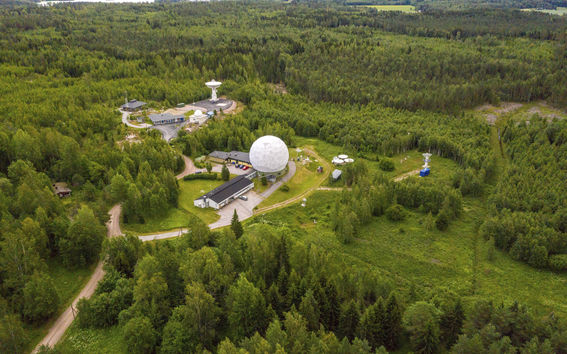Metsähovi Radio Observatory monitors galaxies and forecasts space weather

The Metsähovi Radio Observatory constantly monitors space and cosmic activity. Pride of place at the observatory goes to its radio telescope, which is 14 metres in diameter and the services of which are highly sought-after all around the world. Joni Tammi, Ph.D., was appointed Director of Metsähovi Radio Observatory on 1 July 2014.
Metsähovi is internationally renowned for the research it conducts on active galaxies, known as quasars. In quasars, part of the material falling into the supermassive black hole at the centre of the active galaxy is ejected from the galaxy in the form of two enormous jets. These black-hole powered jets are among the most powerful radiation emitters in the Universe.
A comprehensive understanding of the jets can be obtained by combining measurements carried out at different frequencies. Observations made using the Metsähovi Radio Observatory's large radio telescope are carried out at various radio frequencies between 2 and 150 GHz, and it is the only telescope in the world monitoring the galaxies at 37 GHz.
– The jets tracked by the telescope move close to the speed of light and, therefore, allow us to study the physics of extreme conditions and the theory of relativity. These extra-galactic emissions help us to better understand black holes and the history of our universe, explains Joni Tammi.
And when several radio telescopes are connected together, a single extraordinarily high-resolution virtual telescope is produced. By using the methods of very long baseline interferometry (VLBI) we can make a planet-sized radio telescope. Metsähovi is one of the few research stations working to develop VLBI technology.
– Connecting telescopes on different continents enables us to get more information about the structure of the Earth and the movement of the planet's tectonic plates. This process requires precise coordinates and remote control capabilities. With VBLI measurements, we have determined the location and speed of the European Space Agency's (ESA) Venus and Mars probes more accurately than the spacecraft themselves.
Radio telescopes constantly monitor solar cycles and create solar activity maps which are then used to forecast space weather conditions.
– After a large solar flare, the energetic particles ejected from the Sun can reach the Earth within a couple of days, impacting on electricity grids and interfering with satellites. Forecasting ensures that the large satellites can be switched off on time.
Great teaching supports the needs of working life
Joni Tammi was already researching active galaxies during his doctoral studies at the University of Turku in Finland. Following the completion of his doctorate he spent three years in Ireland at University College Dublin. As Director of the Metsähovi Radio Observatory, Tammi no longer has much time to pursue his own research interests.
– I see my job as that of promoting and advancing the work of others and supporting new educational developments and opportunities in this field. It is essential that we motivate students through astronomy.
Lately, Joni Tammi has not had problems with how to use his free time, as he has been busy completing his teaching qualifications through Aalto University's pedagogics training programme.
– The training opened my eyes to what makes a good teacher and how educational development can support the fostering of working life competencies. In addition to the compulsory scientific and technical elements, it is also important that we get students to take an interest in their own skills and knowledge, which will continue to develop throughout their professional careers.
Metsähovi Radio Observatory is a separate research institute of the Aalto University School of Electrical Engineering and one of Aalto University’s large research and teaching infrastructures. It is located at Metsähovi in Kirkkonummi, Finland, about 35 km west of the university's Otaniemi campus in the City of Espoo.
More information
Photo: Aalto University/Mikko Raskinen
- Published:
- Updated:
Read more news

Get to know us: Associate Professor Maria Sammalkorpi
Sammalkorpi received her doctorate from Helsinki University of Technology 2004. After her defence, she has worked as a researcher at the Universities of Princeton, Yale and Aalto.
Aalto computer scientists in ICML 2024
Computer scientists in ICML 2024
Getting bacteria into line
Physicists use magnetic fields to manipulate bacterial behaviour